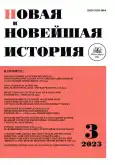No 3 (2023)
Theory and methodology of history
Wilhelm II and the Power System of Germany at the End of 19th and to Begin of 20th Centuries
Abstract
On the basis of a historiographical analysis, the authors of this article attempt to reflect on the thirty-year reign of German Emperor Wilhelm II, taking into account the historically shaped tendencies of power, ideology, social and political organisation, as well as the Emperor's own ideas of monarchy and state. The authors systematise historians' assessments of the concepts of “dual modernization”, the “regime of personal rule by the emperor” and “Wilhelminianism” as well as interpretations of the phenomenon of radicalisation of public opinion and the activities of political parties and popular associations. It is their shared opinion that the far-reaching constitutional guarantees and powers proclaimed and granted to the German public by the 1871 Constitution were in fact substantially circumscribed. The Reichstag, as a social and political institution of power, never really became the main actor in the legislative process with controlling powers over the executive. The German middle class failed to secure the “classical prerogatives of parliamentarianism” (Georg Iggers). The constitutionally enshrined preponderance of monarchical power was reinforced by the alliance of the princes with the agrarian elite, which continued to dominate both economically and politically, occupying key positions in both the bureaucracy and the army. Therefore, due to the comparatively late unification of the country, the preservation of medieval monarchical culture and structures of domination, social groups, associations, unions, political movements and parties became the subjects of modernisation changes during this period of time. The war unleashed by the German monarchy and its subsequent tragedy clearly showed the other side of national unity. All these developments are considered in the context of the transformation of the monarchy, but not in the direction of limiting the personal power of the ruler, but in the direction of the traditional view of it ("the alliance between throne and altar"), which predetermined the final disaster of the reign of Emperor Wilhelm II.
 7-27
7-27


Formation and Creation of the Academy of Sciences of the Azerbaijani SSR (1920–1945) in the Works of Azerbaijanian and Foreign Scientists
Abstract
 28-42
28-42


Heroes and Anti-Heroes of the 1940s: Pendulous Swings in Greek Historiography
Abstract
 43-53
43-53


Modern history
Russia in War for Foreign Interests: Negotiations Between British and Rus-sian Diplomats on the Subsidy Conventions of 1747
Abstract
 54-66
54-66


The Struggle for Oregon in the Last Third of the Eighteenth – First Quarter of the Nineteenth Century
Abstract
 67-83
67-83


20th century
“Saratov Key” to the 1918 Campaign
Abstract
 84-100
84-100


Soviet Historical Science and Foreign Policy Dynamics in the Late 1930s and 1940s: The Mishulin Line
Abstract
 101-116
101-116


Moscow Museums on the Eve and in the Initial Period of the Great Patriotic War: Organization, Structure, Evacuation
Abstract
 117-130
117-130


“It Is Favorable To the Forces of Socialism to Keep the Americans in Southeast Asia Longer”: The Presidium of the CPSU Central Committee in the Determination of the Strategic Line of the USSR in the Second Indochina War of 1965
Abstract
 131-153
131-153


The USSR – Czechoslovakia Commission of Historians: Particularities of Creation and Activities in the 1960s
Abstract
 154-168
154-168


Contemporary history
Political Islam: from History to Modernity
Abstract
 169-181
169-181


Messages
Nikolay Charykov and Friedrich Martens: The Careers of Two Diplomats
Abstract
 182-194
182-194


Arthur Jacob Marder: A Glorifier of the British Sea Power
Abstract
 195-206
195-206


Analysing original documents
American Representatives to the USSR and the Fate of Soviet Religious Policy at the Beginning of the Great Patriotic War. From Father Leopold Braun's Correspondence of 1941
Abstract
In this article, the authors analyse and comment upon four documents from the archives of the Vatican Secretariat of State which reflect the earliest phase of US-Soviet contacts during the Great Patriotic War relating to the question of religious freedom in the USSR. The international reputation of the Soviet Union as a country of deliberate persecution of religion became a domestic political problem for the administration of President Franklin D. Roosevelt in the autumn of 1941, as its attempts to include the USSR in the Lend-Lease programme met with resistance from influential religious circles, particularly American Catholics. These circumstances led the US administration to seek the support of the Vatican, on the one hand, and, on the other, to seek statements from the Soviet leadership that would confirm the latter's commitment to the principle of religious freedom declared in Soviet law. At the same time, Roosevelt himself was convinced that a military crisis would force the Soviet Union to abandon its previous anti-religious policy. This view was also shared by the representative of the Roman Catholic Church in Moscow, the American Assumptionist Fr Leopold Braun. As can be seen from the letters published here, Fr Braun was convinced that the US administration should take immediate and vigorous steps to secure guarantees of religious freedom from the Soviet leaders. His letters were sent both to Washington and to the Vatican, where they were read as confirming the position of the American side in urging the Holy See to show flexibility towards Soviet Russia.
 207-227
207-227


Reviews
 228-231
228-231


 231-234
231-234


 234-236
234-236


 236-239
236-239


 240-247
240-247


Academic life
 248-250
248-250


 250-254
250-254












